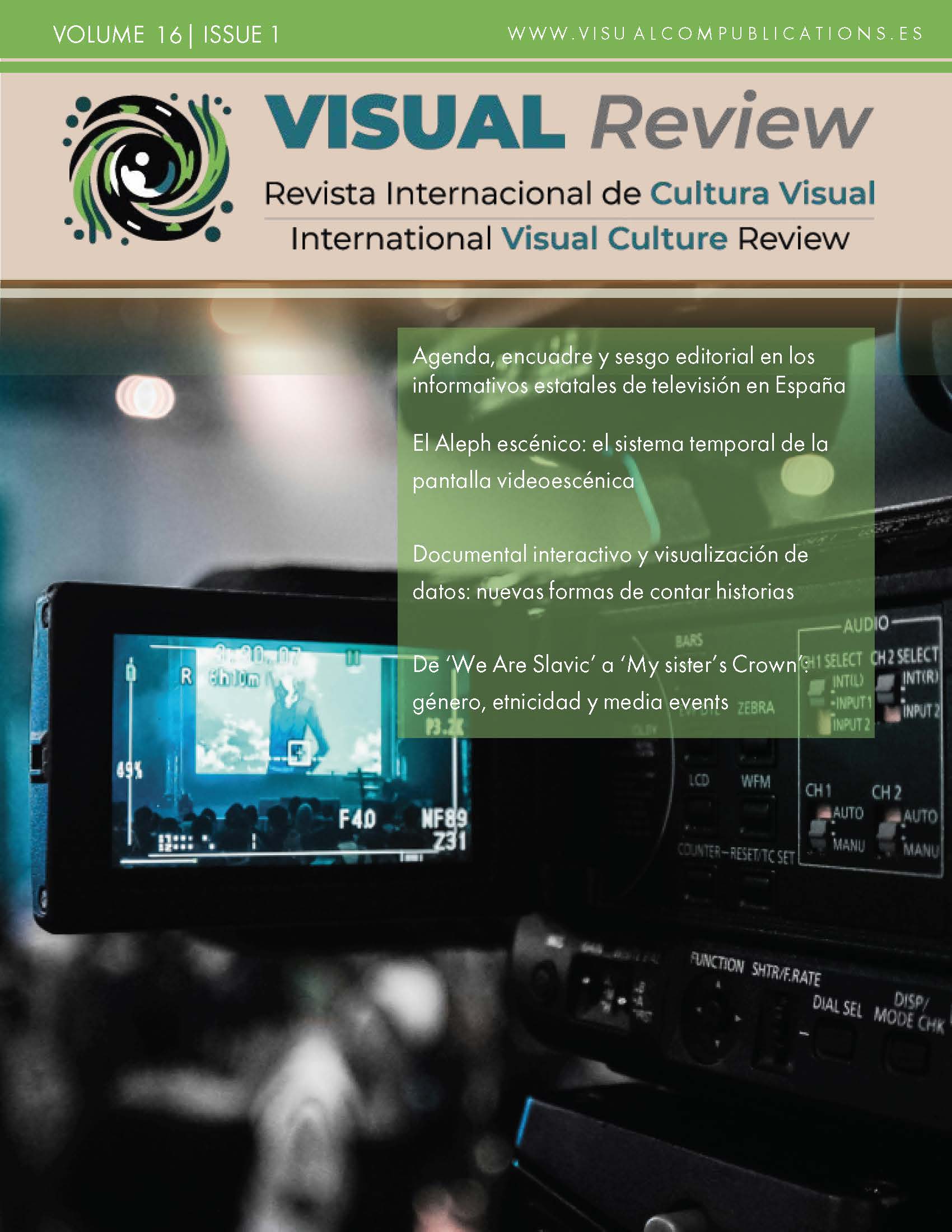Animated Series in the 90s, Between the Procedural Series and Serial
Format and Possible World of Spider-Man (1994-1998)
DOI:
https://doi.org/10.62161/revvisual.v16.5183Keywords:
Animation, Fiction Format, Hermeneutics, Possible Worlds, Procedural Series, Serial, Spider-ManAbstract
The first contribution of the article is the delimitation of the fictional format of an animated series, Spider-Man (1994-1998), a procedural series with serial aspects. The second novelty is of a methodological nature, as it adds to the study of the format the mimesis of world, the object of study of the hermeneutics of possible worlds. In this way, it is understood that the recurring narrative elements in a series not only respond to production factors but also constitute the regularities that suggest the order and meaning of both the socially instituted world in the plot and the personal world of the protagonist.
Downloads
Global Statistics ℹ️
|
1774
Views
|
483
Downloads
|
|
2257
Total
|
|
References
Abellán-García Barrio, Á. (2020). El cambio en las vigencias familiares en ‘1984’, de George Orwell. Carthaginensia, 26(69), 81-102. https://shre.ink/ryLr
Abellán-García Barrio, Á. (2023). Mundos posibles poéticos. El caso de Patria: el pueblo, la novela, la serie. Los Libros de la Catarata.
Albaladejo Mayordomo, T. (1998). Teoría de los mundos posibles y macroestructura narrativa. Análisis de las novelas cortas de Clarín, Murcia: Publicaciones de Universidad de Alicante.
Aristóteles (1974). Poética. Gredos.
Aronson, L. (2000). Televisión Writing: The Ground Rules of Series, Serials and Sitcoms. AFTRS.
Balló, J. & Pérez, X. (1997). La semilla inmortal: los argumentos universals en el cine. Anagrama.
Bordwell, D., Thompson, K. & Smith, J. (2020). Film art: An introduction. McGraw-Hill.
Catela Marcos, I. & Agejas Esteban, J.-A. (2020). Series en serio. Claves éticas en la ficción audiovisual. Digital Reasons.
Chalaby, J. (2016). The Format Age. Polity Press.
Creeber, G. (2015). The Television Genre Book. Palgrave Macmillan. DOI: https://doi.org/10.1007/978-1-84457-898-6
Douglas, P. (2007). Writing the TV Drama Series. Michael Wiese.
Durand, G. (2007). La imaginación simbólica. Amorrortu.
Encinas Cantalapiedra, A. & Reviejo Martínez, E. (2023). Mímesis de acción y significado existencial en videojuegos a través de What Remains of Edith Finch. Revista Mediterránea de Comunicación, 14(2), 311-328. https://doi.org/10.14198/MEDCOM.24332 DOI: https://doi.org/10.14198/MEDCOM.24332
Figuero Espadas, J. (2019). A review of scene and sequence concepts'. Communication & Society, 32(1), 267-277. https://doi.org/10.15581/003.32.37829 DOI: https://doi.org/10.15581/003.32.1.267-277
García Martínez, A.-N. & Nannicelli, T. (2021). Otro tipo de recompensa narrativa: el concepto de “prolongación temporal” como superación de la serialidad televisiva. Área Abierta, 21(3), 349-365. https://doi.org/10.5209/arab.75200 DOI: https://doi.org/10.5209/arab.75200
García Martínez, A.-N., Castrillo Maortua, P. & Echart Orús, P. (2019). La simpatía moral y el “efecto Lucifer”. Mal y redención en Breaking Bad. Revista Latina De Comunicación Social, 74, 383-402. https://doi.org/10.4185/RLCS-201
García-Noblejas, J.-J. (2005). Comunicación y mudos posibles. EUNSA.
Gómez Martínez, P. (2015). La dramedia: rasgos diferenciadores y su proceso creativo. En B. Puebla Martínez, N. Navarro Sierra & E. Carrillo Pascual (Eds.). Ficcionando en el Siglo XXI: La ficción televisiva en España (pp. 175-190). Icono 14 Editorial.
Gómez Martínez, P. & García García, F. (2010). El guion en las series televisivas. Formatos de ficción y presentación de proyectos. Universidad Francisco de Vitoria.
Gutiérrez Delgado, R. (2023). Si Aristóteles levantara la cabeza. Manual de escritura de series. EUNSA.
Hernández Ruiz, V. (2022). Adecuación extensión-intensional en la temporalización de la novela personal o memorias ficticias. Análisis sintáctico-intensional de «Brideshead Revisited» de Evelyn Waugh. Castilla. Estudios de literatura, 13, 296-321. https://doi.org/10.24197/cel.13.2022.296-321 DOI: https://doi.org/10.24197/cel.13.2022.296-321
Itúrregui, V. (2023). Feminismo y geopolítica en el Universo Cinematográfico de Marvel: la ideología y la historia vestidas de fantasía de Viuda Negra, Wandavision y Dr. Strange. Historia y comunicación social, 28(1), 227-238. https://doi.org/10.5209/hics.85154 DOI: https://doi.org/10.5209/hics.85154
Loriguillo-López, A. (2021). Anime complejo. La ambigüedad narrativa en la animación japonesa. Universitat de València.
Mills, B. (2009). The Sitcom. Edinburgh University Press. DOI: https://doi.org/10.1515/9781474471039
Perlmutter, D. (2018). The Encyclopedia of American Animated Television Shows. Rowman & Littlefield.
Propp, V. (1998). Morfología del cuento. Akal.
Ryan, M.-L. (2006). From Parallel Universes to Possible Worlds: Ontological Pluralism in Physics, Narratology, and Narrative. Poetics Today, 27(4), 633-674. DOI: https://doi.org/10.1215/03335372-2006-006
Sánchez-Escalonilla, A. (2014). Estrategias de guion cinematográfico. El proceso de creación de una historia. Ariel.
Saló, G. (2003). ¿Qué es eso del formato? Cómo nace y se desarrolla un programa de televisión. Gedisa.
Tous, Anna (2010). La era del drama en televisión. UOC.
Tobias, R.-B. (1993). 20 Master Plots (and How to Build Them). Writer´s Digest Books.
Downloads
Published
How to Cite
Issue
Section
License
Copyright (c) 2024 VISUAL REVIEW. International Visual Culture Review / Revista Internacional de Cultura Visual

This work is licensed under a Creative Commons Attribution-NoDerivatives 4.0 International License.
Those authors who publish in this journal accept the following terms:
-
Authors retain copyright.
-
Authors transfer to the journal the right of first publication. The journal also owns the publishing rights.
-
All published contents are governed by an Attribution-NoDerivatives 4.0 International License.
Access the informative version and legal text of the license. By virtue of this, third parties are allowed to use what is published as long as they mention the authorship of the work and the first publication in this journal. If you transform the material, you may not distribute the modified work. -
Authors may make other independent and additional contractual arrangements for non-exclusive distribution of the version of the article published in this journal (e.g., inclusion in an institutional repository or publication in a book) as long as they clearly indicate that the work was first published in this journal.
- Authors are allowed and recommended to publish their work on the Internet (for example on institutional and personal websites), following the publication of, and referencing the journal, as this could lead to constructive exchanges and a more extensive and quick circulation of published works (see The Effect of Open Access).













